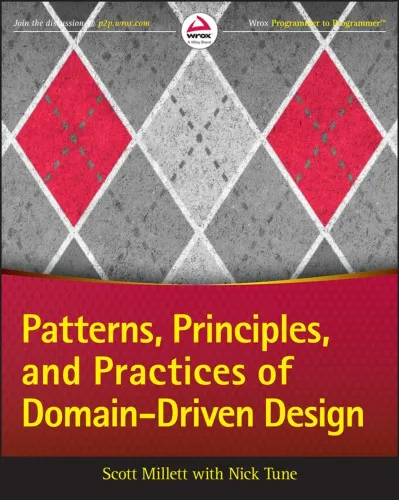Patterns, Principles, and Practices of Domain-Driven Design
4.5
Reviews from our users

You Can Ask your questions from this book's AI after Login
Each download or ask from book AI costs 2 points. To earn more free points, please visit the Points Guide Page and complete some valuable actions.Welcome to the introduction of Patterns, Principles, and Practices of Domain-Driven Design, a comprehensive guide authored by Millett, Scott, and Tune, Nick. This book serves as a strategic resource for anyone who wants to understand the essence of Domain-Driven Design (DDD) and how to apply it effectively in software development. By blending theory with practical examples, it helps developers, architects, and teams unlock the potential of creating software systems deeply connected to the problem domain.
Detailed Summary of the Book
The book provides a deep dive into Domain-Driven Design concepts while addressing patterns, principles, and best practices. It begins with the fundamentals of DDD, explaining its core philosophy: building software that mirrors the language and processes of its business domain. Moving beyond just theory, the authors explore practical strategies for breaking down complex systems using patterns like Bounded Contexts, Aggregates, and Domain Events.
In later chapters, the book tackles modern software development challenges like ensuring scalability, managing distributed systems, and designing for failure. Topics like Command Query Responsibility Segregation (CQRS) and Event Sourcing are covered with practical guidance, making them accessible for teams striving to build resilient systems. Throughout, the book bridges the gap between design techniques and implementation details by tying DDD principles to contemporary technologies such as cloud computing, NoSQL databases, and microservices architectures.
Finally, the book provides actionable advice on team collaboration and communication, key areas often overlooked in technical discussions. By focusing on communication between domain experts and developers, the authors ensure that the technical design stays aligned with business goals.
Key Takeaways
- Understand the Core of Domain-Driven Design: Learn to model complex business domains by capturing their intricacies with building blocks like Entities, Value Objects, and Repositories.
- Master Strategic Design: Discover how strategic tools like Bounded Contexts and Context Mapping guide the division of large domains into manageable subdomains.
- Explore Tactical DDD Patterns: Implement patterns like Aggregate Roots, Factories, and Domain Events for robust domain modeling.
- Improve Collaboration: Enhance teamwork between developers, domain experts, and stakeholders with tools like the ubiquitous language.
- Leverage Modern Architectures: Utilize DDD concepts in microservices, CQRS, Event Sourcing, and cloud-native software systems.
- Handle Complexity: Learn techniques to manage domain complexity and adapt to evolving business requirements.
Famous Quotes from the Book
Here are some memorable quotes from the book that distill its essence:
"The heart of software development lies in building a deep understanding between developers and the domain experts they work with."
"Bounded Contexts are a way to contain the inevitable complexity of large systems by drawing boundaries that align to the business."
"A model isn’t just a diagram; it’s a cohesive set of ideas that serve as the foundation for design and implementation."
Why This Book Matters
As industries increasingly adopt Domain-Driven Design, this book stands as a cornerstone for mastering the methodology. For professionals tackling complex software systems, it not only provides a rich theoretical foundation but also dives into modern, practical implementations. Whether you are building enterprise-grade solutions or microservices, the book equips you with the tools to create software systems that align with organizational goals.
Additionally, the book emphasizes the cultural and collaborative aspects of DDD, enabling developers and domain experts to speak the same language and work towards shared goals. It champions the idea that well-crafted software requires not just technical skill but also a deep connection to the business it supports.
In a world where software systems grow larger, more distributed, and increasingly complex, Patterns, Principles, and Practices of Domain-Driven Design provides a much-needed roadmap for developers and architects, ensuring that systems remain functional, maintainable, and rooted in real-world value.
The knowledge within these pages will serve as a guide for professionals aiming to bridge the gap between technical craftsmanship and business-driven solutions.
Free Direct Download
You Can Download this book after Login
Accessing books through legal platforms and public libraries not only supports the rights of authors and publishers but also contributes to the sustainability of reading culture. Before downloading, please take a moment to consider these options.
Find this book on other platforms:
WorldCat helps you find books in libraries worldwide.
See ratings, reviews, and discussions on Goodreads.
Find and buy rare or used books on AbeBooks.
1119
بازدید4.5
امتیاز50
نظر98%
رضایتReviews:
4.5
Based on 0 users review
"کیفیت چاپ عالی بود، خیلی راضیام"


